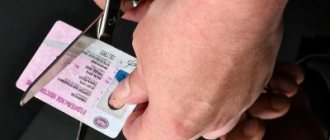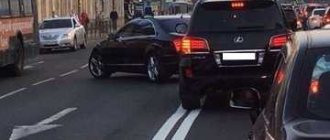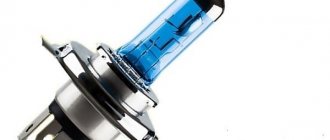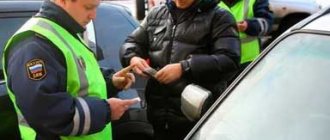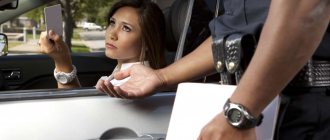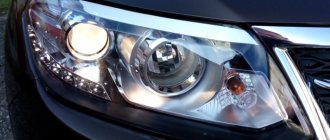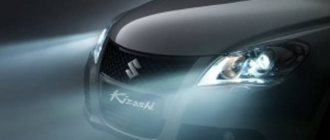Dear reader, if you are interested in how deprivation of rights occurs for illegally used xenon, then this article is for you. We will talk about the types of lamps, the possibilities of their use and restrictions on use. Let's discuss when a penalty such as deprivation of a license can be used. Now let's talk about everything in order.
Our material will be useful to all car owners who are already using or planning to use this type of lamps. Knowing all the intricacies of their operation, you will learn how to avoid fines and deprivation of documents for xenon. Perhaps this is one of the main points that you need to pay attention to now.
Important!
For unauthorized equipping of a car with xenon equipment, severe penalties are provided in the form of deprivation of rights.
Positive aspects and history of application
Xenon emits light that is close in its characteristics to daylight. This is why it becomes much easier for the driver to distinguish objects at night. The person driving is not afraid of bad weather conditions. Xenon light is able to pass through drops of fog or rain, perfectly illuminating the road surface. This protects the driver's eyes from unnecessary strain. In addition, xenon light creates a wider beam. And this ability allows him to better see those objects that are on the sidelines.
Xenon lamps are durable. Their service life ranges from 2800 to 3000 hours (for halogen ones - 180-500 hours).
Xenon gas-discharge lamps began to be installed in cars back in 1992. They differed favorably from halogen lamps in their greater light output and low energy consumption.
Self-installation of xenon
Any car enthusiast can purchase such light bulbs without much difficulty. This product, usually made in China, is offered in all markets selling spare parts. Some car enthusiasts purchase such bulbs so that the headlights of their car provide brighter light in the dark, while others strive to give their “iron horse” a more impressive look.
However, everything is not so simple. A car equipped with such a light begins to look somewhat provincial, and on the road the police are constantly trying to stop the driver in order to issue a fine for xenon. Why is everything happening like this? The answer is quite simple. It is not enough to install one xenon. Car headlights must be equipped with washer nozzles, and in addition, to form the correct luminous flux, a special corrector is required. In the absence of such equipment, you will definitely receive a fine for xenon installed without permission.
There is one more nuance. Your vehicle's headlights should be marked with symbols such as DCDR or DCR. If they are not, then you will also receive a fine for installing xenon. There are cars with DC/HR markings on their headlights. They can be equipped with gas discharge bulbs as a source of low beam only.
What problems might arise?
The design of the headlight, designed to use a gas-discharge lamp, is characterized by the presence of reflectors that focus the light on the road in front of the car. With abnormal xenon, the light is scattered, illuminating the oncoming lane and the side of the road. What undesirable consequences can the use of xenon headlights lead to? This may lead to the following:
- blinding oncoming and passing drivers. A person loses orientation in space, complete restoration of vision occurs after a few minutes;
- blinding pedestrians;
- the inability to correctly estimate the distance to a car with abnormal xenon leads to dangerous maneuvers when overtaking;
- additional shadows resulting from improper lighting create the illusion of an obstacle on the road. The driver can apply emergency braking or take a sharp turn to the side, creating an emergency situation.
The absence of a washer when using non-standard xenon leads to the fact that dirt on the headlights acts as a diffuser, visibility for the owner worsens, and the likelihood of blinding oncoming drivers increases.
Negative sides of xenon
Why does the traffic police impose fines for installing brighter lamps in a car? The fact is that such light blinds oncoming drivers and those driving ahead.
Car owners who decide to install xenon also encounter problems. Such lamps are quite difficult to adjust. In addition, the computers of modern cars do not perceive them as a working element of the circuit, diagnosing a malfunction.
If the headlight is designed for a halogen lamp, then installing xenon may result in flickering light. This mode quickly tires the driver's eyes.
Taking into account the fact that blinding bright light can create an emergency situation on the road, in the legislation of the Russian Federation there is administrative responsibility that allows the traffic police to issue fines for the use of external lighting devices by the car owner that were not originally provided for in the design of the vehicle.
Is it possible to install xenon without breaking the law?
The installation of xenon headlights is permitted by law only in cars in which the possibility of such an improvement was provided from the factory. To be more specific, the car must meet 3 criteria:
- have headlight washers;
- have an auto-corrector for the angle of inclination of lighting devices;
- have certain markings on the headlights.
Fulfillment of the first 2 criteria is easy to determine. The headlight markings are a little more complicated:
| Mark | Meaning |
| DC/DR | This headlight has two separate lamps: low beam and high beam. Both can be replaced with xenon ones. |
| DCR | If this marking is applied to the headlight, it means that one lamp is used for both low and high beam. Instead, you can also install xenon with switchable modes. |
| HR/DC | A headlight with this marking again has two lamps, but only the main beam lamp can be replaced with a xenon one. The low beam block is not suitable for xenon. |
| DR/HC | The point is similar to the previous one, however, in this case, xenon can be set in reverse only for low beam. |
| HR/HC | This marking has different meanings for European and Japanese assembled cars. You can install xenon in Asian cars with this marking, but not in European cars. |
Amendments to the Code of Administrative Offenses
Since 2012, traffic police officers began to pay attention to which lamps in the headlights of moving cars illuminate the road for drivers. Such actions were due to the introduction of some changes to the Administrative Code. Art. 12.4 and 12.5 of this code began to indicate that only those lamps should be installed in cars that comply with the “Basic Rules for the Operation and Approval of Vehicles” and also do not conflict with GOST. These documents also apply to xenon. They allow its installation only if it is provided for by the car manufacturer.
The Code of Administrative Offenses provided for a fine for xenon in fog lights if the car owner independently changed the design of his car. The citizen had to pay 2.5 thousand rubles and part with the lighting devices. A larger fine was imposed on the company’s transport – from 15 to 20 thousand rubles. As for the individual entrepreneur, they charged from 400 to 500 thousand rubles for installing xenon.
Cancellation of registration for xenon
If the design of the car is changed in any way outside the limits provided by the factory, then the car ceases to meet the requirements of technical regulations. Such a car can be deregistered without the participation of its owner. Most often, this measure is resorted to if the design of the vehicle has undergone significant changes, for example, gas cylinder equipment has been installed. However, in theory, they can also deregister for illegal installation of xenon - this will be legal.
Some time after the traffic police inspector issues a protocol for the installation of xenon, you may receive a notification that the registration of the vehicle has been completed. The driver will also receive a written request to re-pass the technical inspection at the traffic police. If no violations are detected during maintenance, the car will be registered again.
If you do not pay attention to this requirement and continue to drive without registration, you may receive even more fines. The first inspector who stops can look up the driver’s data in the database and find out about the termination of registration. In this case, he will issue a fine of 500 rubles. according to Part 1 of Art. 12.1 Code of Administrative Offences. The next time you stop, the punishment will be stricter: a fine of 5,000 rubles. or deprivation of rights for up to 3 months.
The need for a ban
Traffic police fines for xenon have left many motorists bewildered. Why punish for installing more efficient light sources? However, there are quite a lot of arguments for the application of this law.
For those who were outraged by the innovation, it is worth saying that xenon cannot always improve visibility on the road. Headlights of older car models are not able to create the necessary beam of light. In addition, the owner of a converted car has to solve a large number of problems. Among them: - lack of concentration of light beams over a long distance, which allows you to see only nearby objects; — poor quality xenon made in China.
All this, as well as the creation of an emergency situation due to blinding bright light, made it necessary to prohibit the independent installation of overly bright lamps.
Opinion of road users
It’s too late to talk about the legality of the innovations in the Administrative Code. Changes have been made to the Code, and we have to put up with it. However, there is still no unity on this issue. Some drivers completely agree with such a harsh punishment. They explain their position by the fact that bright xenon light often becomes the culprit in creating emergency situations on the road. There are other opinions. There are drivers who are convinced that the bright xenon light helps them notice a pedestrian or a dangerous hole on the road at night in time, thereby preventing a possible accident. Of course, both sides have weighty arguments.
Visual inspection
How to avoid a fine for xenon in the form of deprivation of rights? First of all, it is necessary to understand how a traffic police officer can visually determine whether lighting devices comply with technical regulations. In road conditions, this can only be done by markings on the body or glass of the headlights. If the design feature of the car allows only halogen lamps to be installed on it, then we can see the symbol H. For xenon headlights there is a designation D. It happens that there are no markings on the lighting devices at all. This indicates that the headlights are designed for conventional incandescent lamps.
As a rule, the traffic police inspector is limited to checking the markings. He simply does not have the necessary authority for other actions. This benefits many drivers. They use stickers that indicate the xenon type of headlight. Such dodgers simply erase the old markings. Of course, the issue can be resolved this way. However, this is very dangerous. If the traffic police inspector identifies this trick, then it will not be possible to escape punishment.
Fog lights are also headlights, the same prohibitions
The same applies to installing xenon in fog lights. The same requirements apply to them as to headlights. That is, if the design does not provide for the installation of xenon, then the punishment for this administrative violation will be the same - deprivation of rights.
However, a fine is not always provided for xenon in fog lights, as well as in the situation with headlights. It all depends on the type of lamps provided by the manufacturer, as well as the correspondence of the markings of the lamps and headlights. And for xenon headlights, the markings may be as follows:
- DC – xenon lamps can be used for low beam;
- DR – for high beam;
- DCR - gas discharge sources are used in both modes of headlight operation.
If the marking contains letters, for example, HСR, then only halogen lamps are installed in the headlights - in this case, the use of xenon lamps is already prohibited. The simple C, R and CR markings indicate that only incandescent lamps are used.
Exceptions to the rules
Sometimes, at the time of purchasing a car, it was not equipped with xenon headlights, but today the manufacturer produces this model with xenon. If you also want to install xenon lamps in these headlights and hope not to get fined for xenon in 2021, then it is better to purchase new special headlights.
They should already be equipped with an automatic light beam corrector and washer. This way, you won’t be able to get caught by a traffic police officer by accident. But only a technical supervision inspector and exclusively at a stationary post can determine the presence of xenon bulbs in the headlights of a car.
Video: How to install xenon so as not to be subject to deprivation of rights
Legal ways to solve the problem
You can avoid punishment in the form of deprivation of your rights and provide yourself with bright light at night in another, simpler, but not cheaper way. It involves installing legal xenon headlights on the car. There will be a D mark on their body, indicating the legality of bright lamps.
However, not many owners will be able to afford such a conversion of their “iron horse”. In addition, there are car models for which it is impossible to find standard xenon. In this case, tuning headlights equipped with lens modules will help solve the problem. It is in them that you can install xenon lamps with a glow temperature not exceeding 4300 K. This is a wonderful option. It will allow the light to maintain the necessary power and the color to be similar to halogen. It is almost impossible to recognize behind the lens whether it is xenon or not. There is another legal way to enhance headlights. You can simply polish the glass. The effect will also be obtained when replacing old headlights with new ones, because plastic loses its light transmittance over the years due to various external influences.
Tinted glass
What tinting is allowed
Issues of vehicle compliance with safety standards are regulated by the Technical Regulations of the Customs Union TR CU 018/2011 “On the safety of wheeled vehicles.” This is not only tinting, but also all other types of modifications, as well as safety parameters of manufactured or imported cars.
Regarding tinting
The Technical Regulations have a number of requirements:
- the light transmission of the windshield and front side windows (including the front door windows) should not be lower than 70
%; - a strip of light-protective film no wider than 140 millimeters can be placed at the top of the windshield;
- if there are external rear-view mirrors, then the light transmission of the rear side and rear windows is not standardized (otherwise the rear window must also provide at least 70% light transmission);
- tinting should not distort the perception of white, yellow, red, green and blue colors, and also have a mirror effect.
The rules are quite clear - either the tint fits into them, or it is prohibited to move with it. No permits
Tinting that does not meet the standards is not provided.
In addition, one fact needs to be taken into account - the light transmission indicator includes both the glass itself and the tinting. New glass from the factory can already absorb up to 10% of light without any tinting (this is a physical property). If the glass is several years old, its light transmission may drop to 70% - then it will be impossible to install any tint in principle.
Car enthusiasts have found a seemingly ideal way to avoid punishment for incorrect tint - make it removable
. There are several options for removable tinting - these are curtains and screens that are attached to the door, electronic tinting (changes depending on the lighting) and gel film, which is easily glued and removed.
The traffic police inspector may punish the driver if the parameters of the removable tinting do not meet the standard. But to do this, he must have time to measure the light transmission before the driver removes it. If the inspector does not have time to measure the light transmission or he does not have a special device with him, the maximum that threatens the driver is an order to eliminate the violation on the spot.
Another popular option, athermal film, is adjustable like any other tint. The inspector will measure the light transmission, and if it is below 70%, there will be a fine.
You won't be able to avoid a fine if the tint "from the factory" doesn't pass inspection.
. The largest Bor glass factory in Russia has been producing glass with a light transmittance of at least 70% since 1988, but since 2002 there is a risk of obtaining glass with a lower percentage.
Imported cars are checked for compliance with the same regulations, so a model with inappropriate tint will not receive a Vehicle Type Approval (VTA).
How they check and what the punishment is
Until recently, only technical supervision inspectors could check the compliance of glass light transmission with standards. The situation changed when traffic police inspectors received this right. The department's regulations give inspectors the right to stop cars that have visually visible signs of violations of safety requirements (including tinting).
Also, previously it was possible to check the level of light transmission only at stationary posts. Now this also does not work - any inspector anywhere
.
The test itself must be carried out with a special device. Today there are 3 certified ones - Tonic, Blik-N and Light.
The inspector must have the appropriate documents for the device (passport and certificate), and the light transmittance must be measured under certain atmospheric conditions:
- air temperature from -5 to +20 degrees;
- relative humidity from 45 to 75%;
- atmospheric pressure from 730 to 790 mm Hg. Art.
These are the requirements for one of the devices (Tonic), for others they may differ slightly. The parameters are indicated in the passport.
In some cases, the traffic police inspector does not have a device for checking light transmission with him and he requires you to go to a stationary post
. This requirement is illegal - the inspector may demand to go to the post if an administrative offense has been registered. It will be impossible to compile it without verification.
Punishment for tinting can be carried out under two articles of the Code of Administrative Offenses:
- Part 3.1 of Article 12.5 “Driving a vehicle on which glass is installed (including those covered with transparent colored films), the light transmission of which does not meet the requirements of the technical regulations on the safety of wheeled vehicles” - a fine of 500 rubles
; - Part 1 of Article 20.25 “Failure to pay an administrative fine on time” – a fine of 1000 rubles, or administrative arrest
for up to 15 days, or compulsory work for up to 50 hours.
Fine under Art. 12.5 is issued when a violation is first detected. If the violator does not pay it and does not eliminate the violation itself (that is, does not remove the tint), a more serious punishment applies, up to and including administrative arrest. Practice shows that the chances of such violators having a two-week unscheduled vacation are really high.
You can also get punished under Article 19.3 of the Code of Administrative Offenses of the Russian Federation “Disobedience to a lawful order of a police officer...” - a fine of 500-1000 rubles or arrest for up to 15 days if you refuse to open the doors to check the tinting.
There is only one conclusion - do not violate the rules of the Technical Regulations and do not stick on tinting that will reduce light transmission below 70%.
Fans of “private” driving have only one hope - a bill has been introduced
, proposing to abolish fines for improperly tinted windows altogether. It was introduced by LDPR deputies, which reduces the chances of approval by parliament to almost zero.
Legal advice
Traffic police officers do not make any claims against legal xenon. It is worth remembering that only state technical inspection inspectors can determine whether headlights comply with existing technical requirements. Moreover, they can do this either at the inspection line, or by going on a raid with traffic police officers.
The use of illegal xenon is classified as a violation of Article 12.5, Part 3 of the Code of Administrative Offenses of the Russian Federation. Let us remind you that according to this article, the driver faces deprivation of his license from six months to a year. Professional lawyers know how to find a loophole in the law, replacing such a severe punishment with a fine of 500 rubles. To do this, you will need to prove that your actions can be qualified under Article 12.5.1 of the same Code, which prohibits the operation of a vehicle with a number of malfunctions. The list of restrictions includes the color of the lights, as well as non-compliance of their operating mode with the requirements set forth by the “Basic provisions for the admission of a vehicle to road traffic.”
In paragraph 3.1 of Art. 12 of the Code of Administrative Offenses states that deprivation of rights is possible if the design of the machine does not correspond to the type, quantity, color, operating mode and location of lighting devices. Which of this list is violated when installing xenon? The location, as well as the number of headlights, their mode of operation? No! The color of the lamps will also comply with GOST if their radiation temperature does not exceed 6000 K. As for the type of lamps, the car instructions usually do not contain instructions prohibiting the installation of xenon.
As a result, all these actions can be brought under Art. 12.5. Part 1 of the Code of Administrative Offenses of the Russian Federation. And this threatens with a warning or a fine of up to five hundred rubles.
Deprivation of rights for xenon in 2021
Fines are not all that threatens violators. In 2021, they may lose their license for xenon. According to Article 12.5 of the Code of Administrative Offenses of the Russian Federation , a driver who violates the rules is suspended from driving a vehicle.
The term of punishment is set individually . The minimum period for which rights for LED lamps are deprived is 6 months, and the maximum is 1 year . At the same time lighting devices that created a danger for other road users are confiscated.
The punishment may be commuted . If the driver has violated the rules for the first time and the headlights on the car match the permitted color scheme, a fine will be applied. The type of punishment depends on the individual nuances of the situation and the decision of the court in which the case will be heard.

